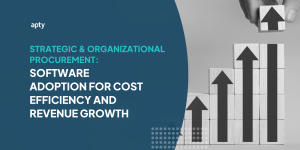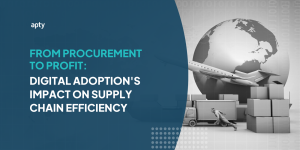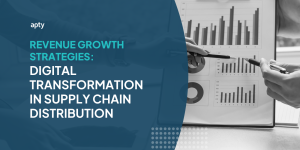In supply chain distribution, digital transformation has emerged as a game-changer that is revolutionizing how businesses operate and interact with their customers. The term “Digital Transformation in Supply Chain” isn’t just jargon—it’s a requisite for survival and growth. Businesses looking for substantive revenue growth strategies should cast a discerning eye on their supply chain processes.
At its core, digital transformation refers to integrating digital technologies into all aspects of a business, fundamentally changing how it operates and delivers value to its customers. In supply chain distribution, this means leveraging digital tools and technologies to streamline and optimize processes, enhance efficiency, and improve customer satisfaction.
Key benefits of digital transformation in supply chain distribution
1. Real-time Visibility with Technology:
- IoT sensors and RFID tags are utilized for tracking goods and inventory in real time.
- Enables continuous monitoring of inventory and shipments at every stage of the supply chain.
- Mitigates stockouts and overstocks by enhancing inventory management.
2. Accurate Demand Forecasting and Planning:
- Real-time visibility leads to more precise demand forecasting and planning.
- Helps businesses respond promptly to changing market trends and customer demands.
3. Automation for Efficiency:
- Automation of manual tasks through digital solutions like automated order processing and fulfillment systems.
- Reduction of errors, speed improvement, and overall operational efficiency enhancement.
4. Seamless Customer Experience:
- Integration of digital technologies for providing real-time order updates to customers.
- Personalized recommendations based on preferences and purchase history.
- Offering flexible delivery options to enhance customer convenience.
5. Customer Satisfaction and Loyalty:
- Improved customer satisfaction through real-time updates and personalized experiences.
- Strengthening of customer relationships, leading to increased loyalty and repeat business.
Digital transformation in supply chain distribution is a paradigm shift that offers immense opportunities for businesses to improve their operations, optimize efficiency, and deliver exceptional customer experiences. By embracing digital technologies and reimagining traditional processes, companies can stay competitive in today’s rapidly evolving marketplace and drive sustainable growth. Let’s explore how integrating digital transformation can be a keystone for revenue expansion.
Understanding Digital Transformation in Supply Chain Distribution

When discussing Digital Transformation in Supply Chain, we’re talking about an all-encompassing shift beyond the rudimentary adoption of digital tools. It transforms all supply chain elements, from procurement to production and distribution to customer service. It’s a top-to-bottom reimagining of operations enabled by technology.
Procter & Gamble’s, a multinational consumer goods corporation, “Always On” supply chain initiative is a compelling case study in Digital Transformation in Supply Chain. The initiative employs cloud computing, data analytics, and real-time monitoring systems to enhance performance metrics like order accuracy, on-time delivery, and inventory turnover. P&G’s initiative has gone beyond merely implementing new technology; it has restructured the supply chain to be more agile and responsive.
According to a report by The Wall Street Journal, P&G reduced its inventory by $2 billion while still meeting consumer demand more effectively.
Beyond Technology: A Holistic Transformation
Contrary to common understanding, Digital Transformation in the Supply Chain isn’t merely about swapping old tech for new. It’s a holistic change impacting organizational culture, operational procedures, and partner relationships.
In partnership with IBM, Walmart has implemented IoT and blockchain to monitor food safety in its supply chain. It’s not just about adding a sensor to a food item; it’s about changing how food safety is managed and controlled from farm to table. According to IBM, this initiative has reduced Walmart’s tracking time from seven days to just 2.2 seconds, a monumental improvement in efficiency.
Benefits: Efficiency, Cost Reduction, and Customer Experience
The ultimate goal of Digital Transformation in the Supply Chain is to deliver tangible benefits such as increased efficiency, cost reduction, and an enhanced customer experience.
Efficiency: According to Gartner, companies that have successfully implemented digital initiatives in their supply chain have achieved up to a 25% increase in efficiency.
Cost Reduction: A study by the Hackett Group has shown that digital leaders have reduced their operational costs by up to 20%.
Enhanced Customer Experiences: DHL’s On Demand Delivery platform is a system that leverages machine learning algorithms and real-time data analytics to provide customers with flexibility and visibility into their shipments. According to DHL, these features have led to a 60% improvement in first-time delivery success, significantly boosting customer satisfaction rates.
Read more: Top 10 SCM Software for Your Enterprise | Apty
The Impact of Digital Transformation on Revenue Growth

Digital transformation directly influences revenue growth by optimizing operations, reducing costs, and increasing the bottom line. By embracing digital tools and strategies, companies can improve customer experience, make data-driven decisions, explore new revenue streams, and innovate to drive business growth. Embracing digital transformation is no longer a choice but necessary for companies looking to thrive in the digital age.
Coca-Cola, a beverage household name, initiated a digital transformation involving AI to forecast equipment malfunctions in their manufacturing plants. By pre-empting these issues, they reduced downtime by 30%, boosting production and revenue.
When we say Digital Transformation impacts revenue, the numbers speak for themselves. According to a 2020 IDC report, companies that invest in the digital transformation of their supply chains can expect an increase in revenue of up to 20%.
Another example is Unilever, another consumer goods giant. Through implementing digital twin technology to simulate their supply chain operations, Unilever identified inefficiencies and adjusted strategies in real-time, resulting in a reported 2-3% increase in overall revenue.
Key Strategies for Driving Revenue Growth through Digital Transformation

Embracing digital transformation isn’t just a matter of staying current; it’s a strategic imperative for driving revenue growth. As we’ve established, implementing digital tools and processes in your supply chain can yield significant financial benefits. But how exactly can this be accomplished? The answer lies in a multi-pronged approach that leverages various strategies, each contributing to increased profitability and long-term success. From employing data analytics for insightful decision-making to harnessing the powers of automation, each strategy is a cog in a well-oiled machine aiming for peak performance.
Data-Driven Decision Making
Data analytics is the backbone of digital transformation by providing actionable insights that guide strategic planning and decision-making. Real-time analytics can expose inefficiencies, track performance metrics, and predict trends, allowing for more effective resource allocation and strategy development.
Example: Amazon
Amazon’s Just Walk Out technology is an exemplary data-driven decision-making model in their Amazon Go stores. By collecting data on customer shopping behavior, Amazon optimizes store layout and inventory in real-time, thus reducing stock-outs and improving customer satisfaction, which drives revenue.
Enhanced Visibility and Collaboration
The ability to monitor operations in real-time across the supply chain can lead to better decision-making and stronger collaborations between departments and external partners. With real-time visibility, firms can better anticipate issues, adjust plans on the fly, and coordinate more effectively.
Case Study: Puma & Suppliers
Puma leveraged real-time visibility tools in its supply chain to facilitate supplier collaboration. By doing so, they reduced lead times by 33%, enabling quicker response to market demands thereby driving revenue growth.
Automation and AI
Automation and Artificial Intelligence (AI) are not just about reducing manual effort; they can also dramatically improve decision-making and operational efficiency. From automating routine tasks to utilizing AI for complex problem-solving, these technologies are crucial in accelerating digital transformation.
Example: Tesla
Tesla’s Gigafactory employs high automation and AI in its production lines. This has led to a 40% reduction in labor costs and a significant increase in output, directly influencing revenue growth.
Customer-Centric Approach
In the digital era, the customer truly is king. A customer-centric approach means utilizing digital transformation tools to enhance every customer journey touchpoint, from personalized marketing to real-time order tracking.
Example: Domino’s Pizza
Domino’s has revolutionized pizza delivery through its GPS-enabled real-time tracking service. Customers know exactly when their order will arrive, increasing customer satisfaction and, as a result, boosting re-orders and revenue.
Predictive Analytics for Demand Forecasting
Predictive analytics can play a vital role in managing inventory and demand forecasting. Accurately predicting future demand based on current and historical data can significantly reduce holding costs and stock-outs, thus improving revenue.
Scenario: Zara
Fashion retailer Zara uses predictive analytics to fine-tune its supply chain. Real-time sales data is analyzed to make immediate inventory adjustments, both in-store and online. This agility helps Zara to reduce unsold inventory costs and respond quickly to fashion trends, thereby maintaining steady revenue streams.
Overcoming Challenges and Roadblocks
Navigating the path of digital transformation takes a lot of work. Even with the promise of boosted revenues and optimized operations, the journey has challenges that can hinder progress. This section will explore these challenges and present strategic solutions for overcoming resistance, enhancing data security, and filling the skills gap.
1. Addressing Resistance to Change
Strategy: Inclusive Decision-Making
One of the primary reasons for resistance is a need for more involvement in the decision-making process. To mitigate this, organizations can involve key stakeholders, from frontline workers to management, in the planning and execution stages.
2. Data Security Concerns
Strategy: Layered Security Protocols
Adopting a layered approach to security—combining firewalls, encryption, and regular audits—can bolster defenses against potential breaches.
3. Skills Gap in Handling New Technologies
Strategy: Continuous Learning Programs
An organization can invest in continuous learning programs to train employees on new technologies, filling the skills gap.
4. Integration Complexities
Strategy: Phased Implementation
Instead of a complete overhaul, consider a phased approach to implementation. This can help in easier management and troubleshooting.
5. Budget Constraints
Strategy: ROI-Driven Planning
When budgets are tight, focusing on ROI-driven projects can yield immediate benefits, providing financial leeway for subsequent initiatives.
With the right strategies, organizations can overcome these roadblocks and continue their journey toward fully realizing the benefits of Digital Transformation in Supply Chain.
Future Trends in Digital Transformation for Supply Chain Distribution
- Blockchain for Transparency: Blockchain technology has the potential to improve transparency by enabling immutable, time-stamped records of transactions. This can significantly reduce fraud, errors, and inefficiencies in the supply chain.
- Internet of Things (IoT) for Real-Time Monitoring: IoT technology can provide real-time feedback on the location and condition of goods in transit, contributing to quicker, more reliable deliveries and reduced costs.
- 5G Connectivity: The advent of 5G will drastically improve data transfer rates and latency, allowing for real-time analytics and enhanced automated processes in supply chain operations.
- Augmented Reality (AR) for Training and Operations: AR can assist in visualizing complex supply chain data and offer hands-free guidance for tasks, drastically improving operational efficiency.
- Machine Learning for Predictive Maintenance: Advanced algorithms can predict when machines will likely fail, reducing downtime and maintaining operational efficiency.
- Robotic Process Automation (RPA): RPA bots can take over routine, time-consuming tasks, allowing human workers to focus on strategic activities, thus improving productivity and reducing errors.
- Sustainable and Ethical Supply Chain: Rising consumer expectations and regulatory pressure are pushing companies to adopt more sustainable and ethical practices in their supply chains.
- Voice Technology in Warehousing: Voice-assisted technology can help streamline picking and packing processes, thus reducing the time and human errors involved in these activities.
- Digital Twins for Supply Chain Modeling: Digital twins can simulate physical supply chain assets, providing a testing ground for optimization strategies without real-world risks.
- Cybersecurity in Supply Chain: As supply chains become more digital, cybersecurity measures must evolve to protect sensitive data and ensure operational integrity.
In the quest for revenue growth, digital transformation in supply chain distribution is not optional; it’s essential. Digital adoption platforms like Apty offer the comprehensive training and guidance necessary for a smooth, effective transition to new digital tools. From overcoming resistance to enabling data-driven decision-making, these platforms are a linchpin in your digital strategy.
Apty serves as more than just a facilitator—it’s a game-changer. Apty’s platform provides critical training, real-time guidance, and data analytics that implement new digital tools that are feasible and efficient.
By leveraging Apty’s capabilities, organizations can overcome typical roadblocks like resistance to change, data security concerns, and skills gaps. Moreover, Apty can empower your team to make data-driven decisions directly contributing to revenue growth, turning digital transformation from a challenge into a competitive advantage.
In short, if you’re aiming for sustainable revenue growth, investing in a digital adoption platform like Apty can amplify your efforts in optimizing your supply chain processes. The road to digital transformation has challenges, but the financial and operational benefits outweigh them.













